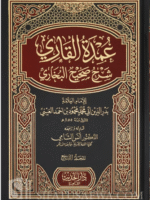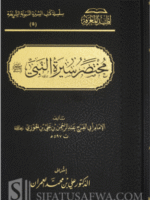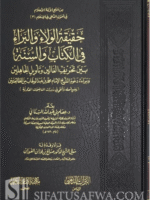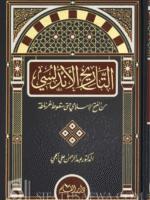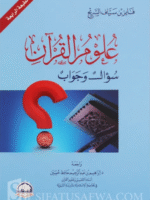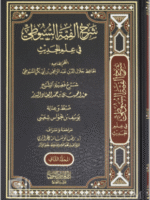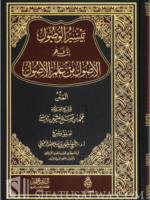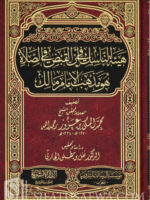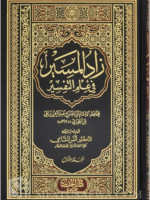Recommended Books
-
‘Umdat al-Qari Sharh Sahih al-Bukhari – Badr ed-Dine al-‘Ayni عمدة القارئ شرح صحيح البخاري – بدر الدين العيني
د.إ 20The State of the Worshipper that Qabd in Salaat (putting the right hand on the left hand) is the Doctrine of Malik – Muhammad al-Makiy Ibn azzuz
This book was written by Muhammad al-Makiy Ibn azzuz al-Maliki al-Tunisi (1270 AH/1334 AH) in which he has proved that the great Maliki scholars believe that it is one of the Sunnahs of prayer to place the right hand over the left when standing, and that it is the doctrine of Imam Malik, may Allah have mercy on him, in contrast to what is reported among the followers of other schools of thought that Sadl (Praying with hands to the sides) is the doctrine of Imam Malik, may Allah have mercy on him.
The author, may Allah have mercy on him, has replied in this book to all the questions, suspicions or objections raised regarding this issue, and refuted any idea of not attributing Qabd to Imam Malik, may Allah have mercy on him.
Beautiful print, verified and annoted.
-
Abridged Biography of the Prophet by Imam Ibn al-Jawzi (Harakat) مختصر سيرة النبي صلى الله عليه وسلم لابن الجوزي
د.إ 20This is a concise and elegant biography of the Prophet Muhammad ﷺ authored by the renowned scholar Ibn al-Jawzi. The book offers a chronological summary of the major events of the Prophet’s life—from his birth and early upbringing to his prophethood, battles, and final moments—written in a style that is both accessible and spiritually uplifting.
Though brief, the work reflects Ibn al-Jawzi’s literary mastery and concern for accurate narration. It is ideal for readers seeking a clear, respectful overview of the Prophet’s ﷺ life rooted in classical scholarship.
A gorgeous and well-presented edition, with the tahqiq carried out under the supervision of the respected Dr. Ali al-Imran. The text includes most of the Harakat.
-
Haqiqat al-Walaa wal Baraa fil Kitab wa Sunnah – Issam Al-Sinani حقيقة الولاء والبراء في الكتاب والسنة – عصام بن عبد الله السناني(تقديم الفوزان)
د.إ 26Haqiqat al-Walaa’ wal Baraa’ fil Kitab wa Sunnah (The truth about loyalty and disavowal in light of the Qur’an and Sunnah) – Issam ibn Abdullah Al-Sinani
The reality of loyalty and disavowal in the Qur’an and Sunnah lies between the disapproval of the fanatics, the interpretation of the ignorant and the exemption of the Da’wah of Sheikh Muhammad ibn Abd al-Wahhab from the two parties.
This book is a compilation of some courses of intellectual advice.
-
History of Muslim Andalusia, from conquest to downfall التاريخ الأندلسي من الفتح الإسلامي حتى سقوط غرناطة
د.إ 20The author is the first to include all of Andalusian history in a single volume systematically at the university level, and he said that it was set up that way intentionally for that purpose. In his book, he relied nearly on 200 references, in four different languages.
The author has divided the history of Andalusia into eight eras:
– The era of the conquest: It is the period in which the armies of Tariq bin Ziyad and Musa bin Nusayr entered Andalusia.
– The era of the Governors: It is the period that followed the conquest, and continued until the end of the Umayyad dynasty.
– The era of the Emirate: It is the period that began with the entry of the Umayyad Abdul-Rahman Al-Dakhil to Andalusia, where he declared it independent (administratively) from the Abbasid state.
– The era of the Caliphate: This era began when Abdul-Rahman Al-Nasir declared himself a Caliph, and it can be considered the pinnacle in the Andalusian history.
– The Age of Taifa Kings: After the fall of the Umayyad Caliphate in Andalusia, the Age of Taifa Kings began, and it is the beginning of the state of frailty in Andalusia.
– The era of Almoravids: This period began with the entry of Yusuf bin Tashfin to the Iberian Peninsula, and was characterized by the elimination of the Taifa kings and the establishment of the pillars of strength in Andalusia.
– The era of Almohads: It began after the fall of Almoravids.
– The era of the Kingdom of Granada: This era represented the last period of the glorious history of Andalusia, before the final fall.
Very nice edition in a large volume, with many notes and references.
-
Sciences of the Qur’an, Question and Answer – Fayez Sayyaf as-Sarih علوم القرآن سؤال وجواب – فايز سياف السريح
د.إ 20The Sciences of the Qur’an are Islamic sciences concerned with the Holy Qur’an, such as the reasons for the revelation and its timing, the various types of Quranic discourse, and so on. Sheilh Fayez Sayyaf As-Sareeh has compiled important and useful information about this science in the form of a question and answer session, which is one of the most effective methods of education and knowledge acquisition.
The book “Sciences of the Qur’an, Question and Answer” covers the following topics:
1- Definition of the sciences of the Qur’an and its origins
2- Revelation
3- The revelation of the Holy Qur’an
4- The first and last revealed Surah of the Qur’an
5- Reasons for the revelation
6- Makkan and Madinan Surahs
7- The virtues, etiquette and characteristics of the Holy Qur’an
Al-Ahruf as-Saba’h (The revelation of the Qur’an in seven different (forms) dialects)
-
Sharh Alfiyyat Al-Suyuti in Hadith Science – Sh. Abdul Muhsin Al-Abbad شرح ألفية السيوطي في علم الحديث – العلامة عبد المحسن العباد
د.إ 20Al-Suyuti’s Alfiyyah is among the most famous poems on hadith science. Among contemporary scholars, the distinguished hadith expert Abdul Muhsin Al-Abbad commented on it thoroughly thirty years ago. Yusuf Shu’aibi transcribed, edited, and fully prepared this commentary, converting the audio lectures into written form.
This is a high quality Sharh which reduces the complexity of the long poem of Imam Suyuti and makes it accessible to many students of Hadith sciences.
-
Taysir al-Wusul ila Fahm al-Usul min ‘Ilm al-Usul – S. Ruhayli تيسير الوصول إلى فهم الأصول من علم أصول للعلامة ابن عثيمين – سليمان الرحيلي Author: Suleyman ar-Ruhayli
د.إ 20Shaykh Suleyman ar-Ruhayli’s explanation of the Risalah in Usul al-Fiqh: Al-Usool min ‘Ilm al-Usool of Shaykh al-Uthaymeen.
Very nice edition with some of the Harakats.
-
The status of the Qabd in prayer for Imam Malik – Al-Makki ibn ‘Azuz هيئة الناسك في أن القبض في الصلاة هو مذهب الإمام مالك – محمد المكي بن عزوز
د.إ 20The State of the Worshipper that Qabd in Salaat (putting the right hand on the left hand) is the Doctrine of Malik – Muhammad al-Makiy Ibn azzuz
This book was written by Muhammad al-Makiy Ibn azzuz al-Maliki al-Tunisi (1270 AH/1334 AH) in which he has proved that the great Maliki scholars believe that it is one of the Sunnahs of prayer to place the right hand over the left when standing, and that it is the doctrine of Imam Malik, may Allah have mercy on him, in contrast to what is reported among the followers of other schools of thought that Sadl (Praying with hands to the sides) is the doctrine of Imam Malik, may Allah have mercy on him.
The author, may Allah have mercy on him, has replied in this book to all the questions, suspicions or objections raised regarding this issue, and refuted any idea of not attributing Qabd to Imam Malik, may Allah have mercy on him.
Beautiful print, verified and annoted.
-
Zaad al-Maseer fi ‘ilm at-Tafseer – Ibn al-Jawzi زاد المسير في علم التفسير – الإمام ابن الجوزي
د.إ 20Zad al-Masir is a standard book in Tafsir (Interpretation of the Qur’an) in which the author has collected the sayings of the early interpreters and others. Sometimes he does not mention the owner of the saying, but he says: Regarding the following Qur’an Verse (he mentions the Verse), there are two or three sayings” and then he relates them in detail. Sometimes he gives preference to one over the others and sometimes he does not. He also discusses the Qur’an recitations, jurisprudence and linguistic issues.
This book has some characteristics, among them the following:
– It was written with words that are exactly to the level of the meaning, and in some cases the words were used to carry the maximum range of meanings possible. He said in the introduction: I have exaggerated in shortening its wording.
– When explaining each Qur’an Verse (mentioned in this book), he lists all the narrations regarding the reasons for their revelation, which will benefit the reader, because knowing the reason for the revelation of the Verse will enable the reader to have a deep understanding about its circumstances.
– He listed some personalities about whom some Verses were revealed
– He mentioned the famous recitations and sometimes the “abnormal” ones.
– He made reference to the abrogated Verses, which scholars differed about whether they were repealed or not? He cited the sayings of the scholars on the subject.

